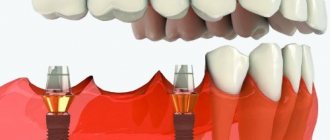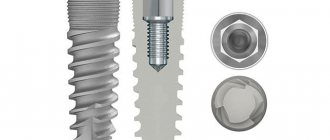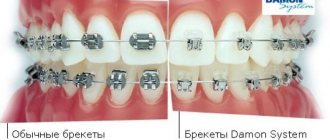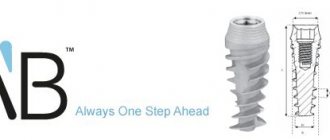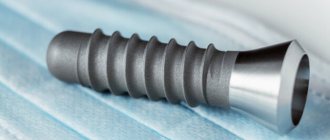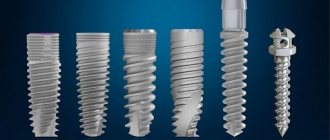| Conical connection with hex positioner. Absolute fixation of the implant and abutment due to the conical connection minimizes micromobility, preserving bone tissue. |
| Platform switching. The MIS C1 implant system is designed using a platform switching principle to create an ideal environment for soft tissue growth and prevent bone resorption. |
| Double thread. The implant thread pitch is 1.5 mm. Self-tapping threads and moderate bone compression ensure initial stability of the implant. |
| Surface The unique surface treatment technology of MIS implants has enabled millions of patients and clinicians to achieve excellent osseointegration results with long-term clinical success. |
| Platform color coding All C1 series implants, superstructures and instruments are color coded to make it easier to identify which prosthetic platform they belong to. |
| Double Stabilization Mechanism (DSM) The conical shape of the MIS C1 implant creates moderate bone compression using the coronal 2/3 of the implant body, providing primary stability. The apical 1/3 of the implant body is designed to promote rapid new bone growth and minimize loss of stability during the first weeks after implantation. |
DSM (Dual Stability Mechanism) principle:
The DSM principle (double stabilization mechanism) is the latest unique method developed by MIS Implants specialists together with other doctors, which consists of creating an ideal environment for accelerated bone tissue growth and ensures a rapid onset of osseointegration. Thanks to the DSM principle, it was possible to achieve the smallest decrease in implant stability in the period 3-5 weeks after installation.
When is implantation necessary?
Replacing teeth with dentures, or simply installing dentures, is necessary if one or more teeth are missing, or a number of teeth are completely missing. The best time to install a new tooth is immediately after removing the old one. Thus, the gum has not yet changed its shape, and the remaining teeth have not yet changed their location.
After surgery, it takes some time for the body to adapt to the implant. It is necessary to visit the dentist to prevent the development of complications.
How it works:
- An individual disposable final cutter forms a bed for a specially shaped implant.
- The installed implant has some free space between the threads in the apical part, which provides an ideal environment for rapid bone formation.
- The implant has a root-like shape and allows for good primary stability due to moderate bone compression in the area of 2/3 of the implant body.
- The implant is motionless, and the free space between the turns in the apical part is quickly filled with blood and creates ideal conditions for the rapid start of osseointegration.
- The DSM principle allows for increased stability of the implant during osseointegration and during the process of new bone formation, especially in the first 3-5 weeks after installation.
MIS implants: turnkey price for 2022
The price for MIS implants will undoubtedly please you, especially if you are familiar with the prices for premium implantation systems made in Switzerland or the USA. The prices below are given based on an analysis of the price lists of clinics in the mid-price segment and economy class.
MIS implants: turnkey price
- with a metal-ceramic crown – from 35,000 rubles,
- with a ceramic crown – from 50,000 rubles,
- the cost of just the operation of 1 MIS implant (without crown and abutment) will be from 22,000 rubles.
Prices for complete absence of teeth - we have already said above that MIS implants are not suitable for implantation using the “All-on-4” method, which is used for permanent prosthetics of toothless jaws (and prosthetics using this method is carried out already 2-3 days after surgery) . But MIS implants are suitable for the usual two-stage implantation method, when in the first stage 4 implants are installed in a toothless jaw and a temporary removable denture is made. This stage will cost about 120,000 rubles.
You will wear a removable denture for about 3-6 months (that is, while the implants are implanted into the bone). After this time, a permanent metal-ceramic bridge prosthesis is made, which will cost on average another 180,000 rubles.
Turnkey prices for implants from other manufacturers –
- AlphaBio (Israel) – → with a metal-ceramic crown – from 35,000 rubles, → with a zirconium crown – from 50,000 rubles.
- Osstem (Korea) – → with a metal-ceramic crown – from 40,000 rubles, → with a zirconium crown – from 50,000 rubles.
- AstraTech (Sweden) – → with a metal-ceramic crown – from 70,000 rubles, → with a zirconium crown – from 80,000 rubles.
- Straumann (Switzerland) – → with a metal-ceramic crown – from 70,000 rubles, → with a zirconium dioxide crown – from 90,000 rubles.
- NobelBiocare (Switzerland) – → with a metal-ceramic crown – from 80,000 rubles, → with a zirconium crown – from 90,000 rubles.
How to choose the right implant type –
For more information about how implants from different manufacturers differ from each other, and what you need to pay attention to when choosing, read the article: “How to choose the right type of dental implant”
Histology (Paulo G. Coelho, DDS, PhD New York University College of Dentistry):
The gist of the clinical study (published in the Journal of Oral and Maxillofacial Surgery) below is that osseointegration between tight bone contact and loose contact will occur in different ways. With tight contact, there is high primary stability of the implant, but as a result, larger areas are subject to necrotic “die-back,” reconstruction, and a resulting decrease in primary (mechanical) stability until new bone formation begins. In the case of “free contact”, the primary stability of the implant is low, but as a result of slight compression of the bone, the number of areas susceptible to necrosis and remodeling is minimized, while the growth of new bone tissue begins in this case much faster, which leads to a faster onset of the secondary phase. (biological) stability of the implant.
What is an enterprise resource planning system?
ERP (Enterprise resource planning) is a special software solution for planning operations with existing and future resources, or more precisely, an operating process management system that operates with information about the company’s resources.
Typically, an ERP is part of a larger management information system that is at the forefront of simplifying routine operations by providing managers with insights and tools to facilitate critical internal business processes.
At the moment, this component is even more popular among large and small enterprises than classic MIS, since it is tailored for more specialized tasks.
Main functions of ERP systems:
- Accounting . Collect data and manage accounts receivable and payable, tax payments, payroll and time tracking. To track the status and manage accounting, ERP systems use special tools, which, as a rule, are created for a specific jurisdiction.
- Production . A common centralized interface for managing production processes: purchasing, budgeting, forecasting and planning. This makes it easier to work with suppliers and clients.
- Business analytics . Collection, storage and analysis of data that is generated during the operation of the enterprise to make more effective management decisions.
- Communication . A common database helps speed up work processes and improve employee discipline.
Scope of ERP
Who uses ERP systems?
Panorama research has shown that the majority of enterprises (more than 80%) are either in the process of implementation or are already using ERP systems, since a specialized solution is always a priority over a general one. This is mainly business in retail, logistics, production, distribution, finance, real estate and information technology. Recently, ERP solutions based on distribution registries have become popular: blockchain, Tangle, Hashgraph.
Depending on the scope of application, ERP covers the following:
- Finance : ledger, fixed assets, accounts payable and receivable, payments, financial consolidation, cash management and miscellaneous collections.
- Personnel : Recruitment, rostering, training, payroll, pensions, benefits, diversity management, retirement.
- Manufacturing : equipment, bill of materials, production processes and premises, operational process management, production and product quality control, product life cycle management, etc.
- Sales : pricing, order entry and fulfillment, checking the buyer's balance, communication capabilities, reporting, sales analysis, commissioning.
- Supply Chain : Planning, O2C, Product Configurator, Purchasing, Inventory, Warehousing, Claims Processing, (Receiving, Storage, Kitting, Packaging).
- Projects : Project and resource planning, costing, work breakdown, time and costs, billing, productivity units and activity management.
- CRM : marketing, sales, service, commissions, customer contacts, support.
- Data transfer : “self-service” interfaces for company employees (with different roles), suppliers and customers.
- Accounting : cost management, budgeting, costing.
Why choose MIS implants
The MIS company is located in Israel and is considered one of the leaders in the field of implantology throughout the world with an annual batch of equipment of 1.5 million dental devices. Israeli MIS implants are sold in 72 countries through a highly organized network of official distributors. They are successfully used by tens of thousands of specialists and have become the choice of millions of patients who have decided to entrust the restoration of their health to this particular company.
It is also important that MIS implants make it possible to preserve your smile for life. With their help, you can restore previously lost teeth, while completely repeating their external and functional qualities. Therefore, choosing this solution guarantees complete relief from all the inconveniences that are possible when wearing dentures or the absence of natural teeth.
Cover screws* and healing abutments
Narrow orthopedic platform
| MC1-00330 | Height range: 2, 3, 4, 6, 8 mm MH-N2330 MH-N3330 MH-N4330 MH-N6330 MH-N8330 | Height range: 2, 3, 4, 5, 6 mm MH-52330 MH-53330 MH-54330 MH-55330 MH-56330 |
Standard orthopedic platform
| MC1-00375 | Height range: 3, 4, 5, 6 mm MH-03375 MH-04375 MH-05375 MH-06375 | Height range: 3, 4, 5, 6 mm MH-53375 MH-54375 MH-55375 MH-56375 |
Wide orthopedic platform
| MC1-00470 | Height range: 3, 4, 5 mm MH-W3500 MH-W4500 MH-W5500 | Height range: 3, 4, 5 mm MH-W3630 MH-W4630 MH-W5630 |
** Screws - plugs are colored according to the color coding of the platforms
Final cutter
Standard sizes of final cutters for SEVEN implants
When using the final cutter, one should take into account its structure and geometric features, and as a consequence, the fact that the implant bed is lengthened (during its final formation) by the size of the apex of the final cutter. This must be taken into account during surgical planning. Below are the dimensions of the apexes of the final cutters based on the diameters of the implants.
* Recommended force when using the final cutter: 200 - 400 rpm.
* Shown in the video: the implant driver, as well as the form of external and internal packaging of the SEVEN implant are no longer used. They have been modified and improved. See section - SEVEN implant packaging
Surgical kit for implant placement SEVEN
Dimensions, diameters and model range of SEVEN implants
Narrow orthopedic platform of the Seven implant
* Seven implants with a narrow platform are equipped with built-in implant drivers.
Seven Standard Orthopedic Implant Platform
Wide orthopedic platform of the Seven implant
Peculiarities
The main material for the production of this dental equipment is medical titanium, and its surface is treated with acid etching and sandblasting. Also, MIS dental implants are endowed with a well-developed outer layer and provide a high degree of osseointegration, which, in turn, has been established through many fundamental scientific works and clinical studies involving world-renowned research institutes and universities. In general, this type of implant is a very aesthetic and durable solution.
